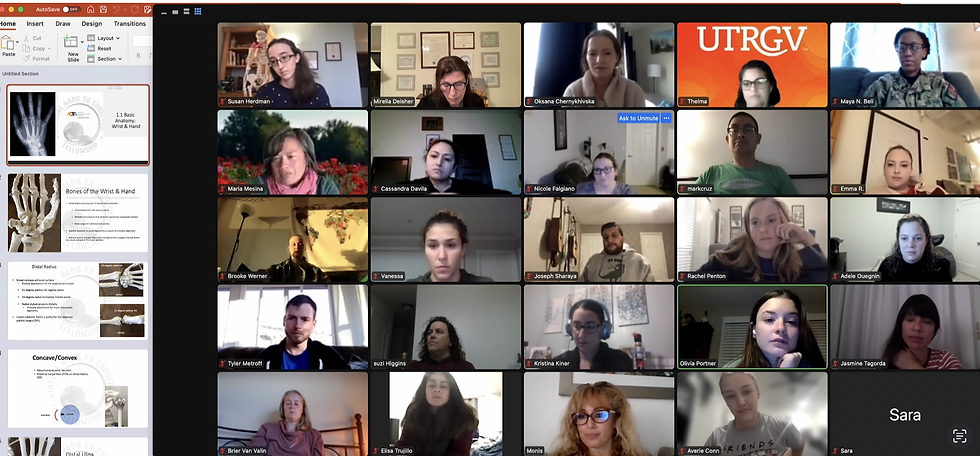Advancing Upper Limb and Hand Therapy Education: Bridging Access and Knowledge Gaps
- Mirella Deisher

- Aug 19
- 3 min read
Written by: Mirella Deisher, OTD, MS, OTR/L, CHT
VHSF, Founder & Faculty
Access to certified hand therapists (CHTs) in the United States remains limited, with significant disparities across regions. These disparities are particularly acute in rural areas, where access to CHTs is severely restricted, resulting in inequities in patient outcomes (Hecox et al., 2025).
These disparities are not simply geographic—they reflect the structure of professional training itself. Most occupational therapy and physical therapy programs provide generalist education, leaving little room to develop the advanced knowledge and clinical reasoning required for the complexities of upper limb rehabilitation. As a result, clinicians often enter practice without the specialized foundation needed to thrive in advanced clinical environments. Without structured post-professional pathways, the gap between generalist education and specialist-level practice persists.

This gap is particularly consequential in upper limb and hand therapy, because rehabilitation extends well beyond surgical recovery. Patients of all ages with neurological conditions such as stroke, spinal cord injury, or upper motor neuron lesions frequently experience profound impairments in strength, dexterity, and coordination. Effective intervention requires specialized approaches—including motor retraining, sensory re-education, and functional integration strategies—that go far beyond entry-level preparation. Certified hand therapists, with their advanced expertise in biomechanics, motor control, and functional outcomes, are uniquely qualified to address these needs.

Meeting the Need: VHSF’s Pioneering Role
The limitations in access and training have long been recognized, and one solution has been to develop post-professional clinical fellowships in different areas of specialization, including upper limb and hand therapy. However, there are several barriers to participation, such as the need to accept reduced pay, the inability to relocate, and the limited availability of clinical fellow positions.
Thus, the Virtual Hand to Shoulder Fellowship (VHSF) was established to remove barriers and close knowledge gaps by educating generalists to the specialist level.
VHSF achieves this mission by providing the first comprehensive, strategically designed curriculum that progresses from foundational sciences to advanced clinical applications. The curriculum is then paired with ongoing remote mentorship and the opportunity to engage with a diverse hand therapy community with clinicians from all over the world, with varying levels of experience.
Unlike fragmented continuing education courses, VHSF offers a cohesive, mentorship-driven program that cultivates critical thinking and advanced clinical reasoning. The fellowship integrates musculoskeletal and neurological perspectives, preparing therapists not only to support functional compensation but also to maximize recovery potential.

The program’s virtual format ensures accessibility across geographic and institutional barriers. This has drawn therapists not only from across the United States but also from regions such as the Middle East, South Africa, Nepal, and Singapore. The global enrollment underscores both the universal demand for advanced-level upper limb training and VHSF’s unique ability to deliver it.
By directly addressing the educational gap identified in the literature, VHSF is not merely participating in the conversation about access—it is shaping the future of advanced upper limb and hand therapy education. As the first program of its kind, VHSF has established a model that bridges knowledge and practice while maintaining global accessibility.
Through this work, VHSF is committed to supporting both patients and clinicians. Clinicians dedicate themselves to providing the highest standard of care, and our mission is to support their efforts by equipping them with the knowledge and skills to achieve excellence in upper limb and hand rehabilitation. In turn, whether patients are recovering from trauma, surgery, or neurological impairment, they gain the opportunity for an optimal recovery experience.
VHSF is mission-driven, serving both therapists and, indirectly, patients as well.
Reference
Hecox, E. E., Boydstun, A. G., Talbot, H. G., Edwards, S. R., Anderson, L., Benedict, K. C., & Walker, M. E. (2025). Geographic disparities in access to certified hand therapists in the United States. Journal of Hand Surgery (American Volume). Advance online publication. https://doi.org/10.1016/j.jhsa.2025.05.013














